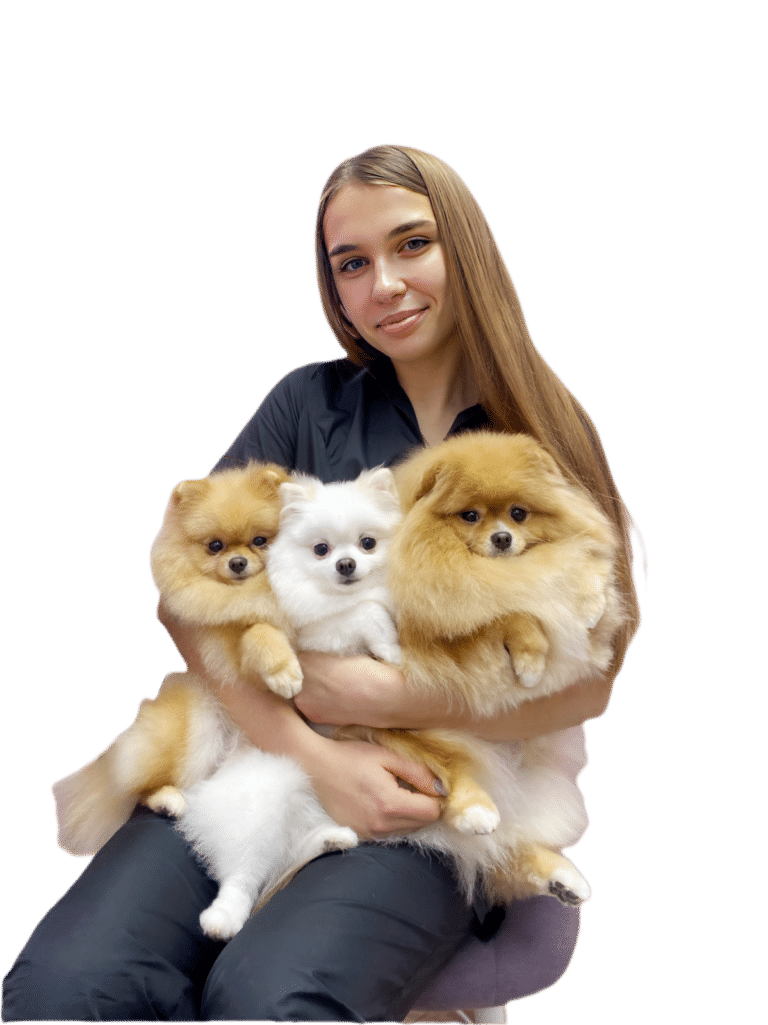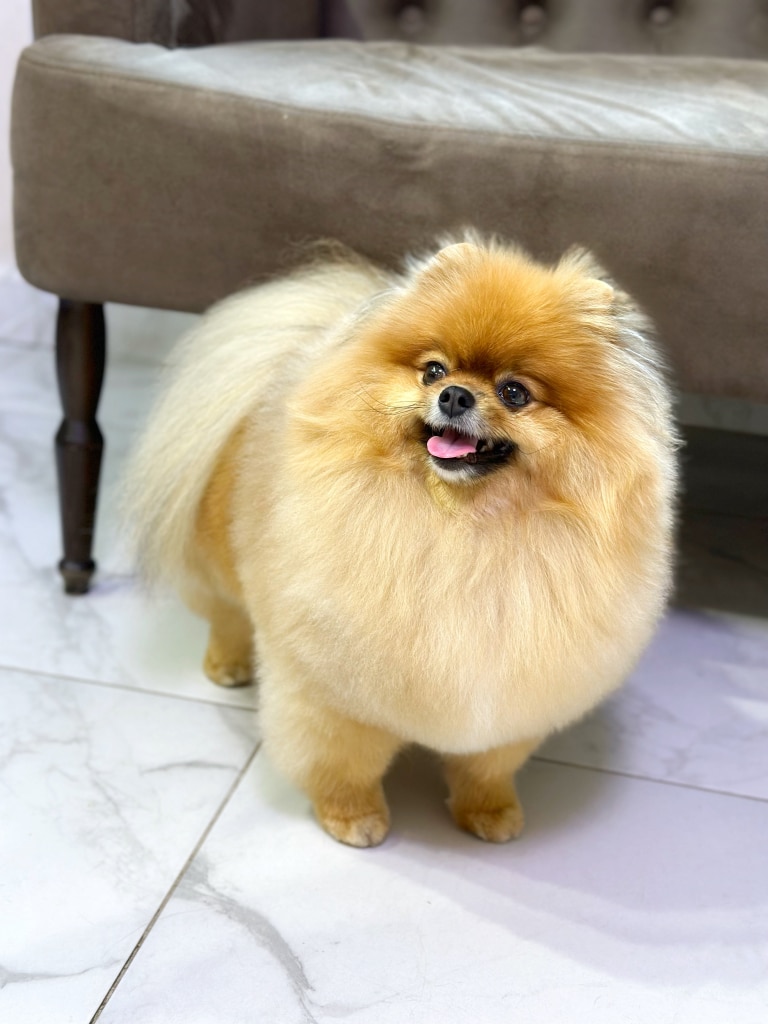




The Spitz breed is among the oldest in the world. They share ancestry with northern sled dogs, and their name comes from the German word “Spitz”, meaning “pointed” — a reference to their muzzle and ears. Spitz dogs were popular across Europe during the Renaissance and often appeared in court life and paintings.
They’re easily recognizable: compact bodies, fluffy tails curled over their backs, thick fur held upright by a dense undercoat, and alert, intelligent eyes. Sizes range from 18 to 50 cm in height and 2 to 20 kg in weight.
Pomeranian (Toy Spitz) — smallest, fluffy, round-shaped body
Small and Medium Spitz — ideal for both home and walks
Large Spitz — rarer, sturdier, with strong guardian instincts
Keeshond (Wolfspitz) — largest, loyal, intelligent with silver-toned fur
They’re smart, loyal, and emotionally intuitive. They adapt to family life quickly and form strong bonds with their owners. Despite their small size, they often behave like bold little watchdogs, alert but not aggressive.
Spitz puppies are playful and curious. Early consistent training helps shape a balanced adult dog.
Their thick, double coat is their pride — and a challenge. While it doesn’t tangle easily, it needs regular brushing to stay full and healthy.
Brush at least 3 times a week (daily during shedding), using slicker brushes, long-tooth combs, and detangling sprays. Focus behind the ears, on the neck, and under the tail.
Bathing: every 3–4 weeks, with deep-clean shampoos and conditioners. Always dry fully in layers with a blow dryer.
V.O.G DOG SALON offers:
Hygienic trims (paws, ears, sanitary areas)
Model cuts (“teddy bear”, classic lines, etc.)
Undercoat removal
Eye, ear, and nail care
Important: Do not shave a Spitz short. Their double coat may not regrow properly, becoming patchy or brittle. It also protects against both heat and cold. That’s why our groomers always preserve coat length for your dog’s health and appearance.

—Clipperwork:
This is a unique method for trimming the Spitz using only clippers. The trimming can be done both in the direction of the fur growth and against it, with the fur length after trimming ranging from 3 to 4 cm.
—Flatwork:
An intricate Spitz trimming technique that combines the use of clippers and scissors. This approach ensures a uniform and impeccable fur length for your pet. Scissors are used not for reducing length, but for eliminating protruding hairs, creating a smooth and consistent texture.
— "Teddy Bear" Trim (Teddy bear style, bo style):
This trim makes the Spitz look like a plush toy. Wool is trimmed all over the body but is kept longer than in the lion cut, maintaining a soft and fluffy appearance.
—"Puppy" Trim:
The Spitz's fur is uniformly trimmed all over the body, providing a neat and well-groomed look, reducing the need for frequent styling and brushing. It's an especially charming style.
— "Lion" Trim (Lion style):
The body and legs are trimmed short, leaving lush fur on the head and tail, making the Spitz resemble a small lion. This is a very risky trim; the undercoat may not grow back after such a short trim. Groomers worldwide do not recommend such trims.

Pomeranians don't require frequent baths due to their thick and unique coat that repels dirt. However, bathing once a month or even less frequently, depending on their activity and environment, is usually sufficient. Excessive baths can strip the coat of its natural oils, making it dry and brittle.
Pomeranian ears can often accumulate dirt and wax. Use specialized ear cleaning solutions and soak a soft cotton ball in it. Gently remove the dirt with light movements and avoid deep penetration into the ear canal.
Typically, Pomeranians' nails grow quickly and can cause discomfort or injuries if they become too long. Clipping the nails once a month or every 6 weeks is optimal. If unsure about the process, it's best to seek a professional.
Pomeranian fur is unique with a dense undercoat and long outer fur. To prevent matting and keep the fur in good condition, daily brushing is recommended, especially during shedding seasons.
Mats in the fur can cause discomfort for your pet. Small mats can be gently brushed out using a fur conditioner. For larger or severe areas, it's best to see a professional.
The coat reflects the overall health of the dog. High-quality food with ample protein, omega-3, and omega-6 fatty acids is ideal. Fish oil, eggs, or supplements can also promote fur health and shine.
Pomeranians' fur health issues might include dryness, brittleness, allergic reactions, or fungal infections. Regular check-ups and proper fur care can help detect and address these issues early.
Taking care of a Pomeranian is time-consuming. It's recommended to spend at least 30 minutes grooming every couple of days, and daily during shedding periods.
To maintain the beauty and health of the fur, it's advised to visit a professional grooming salon at least once a month. This will also help detect potential health issues at an early stage.
The Spitz’s fur is their signature look. It’s fluffy, thick, and needs regular care to always look stunning. But it’s not just about looks. Proper grooming helps prevent skin issues, avoid matted fur, and keeps the dog stress-free.
Firstly, it’s essential to note that the Spitz’s fur has a dual-layer. The outer layer consists of long, rough hairs that protect the dog from moisture and dirt. The inner layer is a soft, fluffy undercoat, keeping them warm and cozy during cold weather. A common trait of the Spitz’s fur is its tendency to get tangled. This can become a problem if you don’t pay enough attention to regular brushing and care. A thoughtful owner understands that a Spitz’s fluffy beauty requires special attention. By turning to skilled experts for Spitz grooming and following care recommendations, you can ensure your pet’s health, comfort, and fantastic appearance for many years.
Grooming a Pomeranian or a German Spitz is a meticulous process since insufficient preparation or the wrong approach can have adverse effects on your pet’s appearance and comfort. Here are a few key prep steps:
Well, it depends on a few things: how active your dog is, the state of its fur, and any specific needs or requests.
If your dog’s out and about a lot, playing in the dirt, it might need baths more often, especially if the fur gets dirty or tangled. In these cases, every 3-4 weeks should do the trick. If someone in your household is allergic to dog fur, washing your dog can help reduce fur and allergens in the home. Here, every 2-4 weeks might be important. But heads up!
Bathing too often can dry out a dog’s skin and fur, causing irritations and flakiness. If your dog’s relatively clean with healthy skin and fur, then bathing every 4-6 weeks, or even less, might be enough. If you’re not sure, professional grooming places can give you the lowdown, considering your dog’s specific needs.
Sometimes, your vet might suggest more regular baths for medical reasons, like if your pup has some skin issues.
The first time you bathe a Spitz, maybe skip the DIY and have the pros handle it. There’s a lot to know, and a grooming salon’s got all the bells and whistles for a top-notch pampering.
When picking out shampoo and conditioner, think about the fur type and skin condition. If your Spitz has short fur, a light, moisturizing shampoo made for short-haired breeds will work. For the long-haired Spitzes prone to knots, you’ll want products specifically designed for long-haired breeds.
If your pup’s got sensitive or dry skin, go for hypoallergenic or moisturizing stuff that won’t cause any irritation. Some Spitzes might not react well to strong scents or chemicals. Stick with mild, hypoallergenic, or natural products. Make sure to check the product ingredients and avoid the cheap stuff. Remember, you usually get what you pay for when it comes to quality shampoos or conditioners.
Spitz hygiene is a big deal if you want to keep this fluffy cloud looking and feeling good. To keep its beauty and health on point, follow these tips from the V.O.G DOG pet salon pros:
Clean the ears with a special solution once a week to fend off wax build-up and infections. Check those eyes from time to time for any gunk or dirt, and gently wipe away with a damp soft cloth. Brushing their teeth daily using a dog toothbrush and toothpaste can really up their oral care game.
When it comes to their private parts, keep ’em clean, especially after walks, using a soft damp cloth to wipe off any dirt or discharge. Watch out for those anal glands: if you spot your Spitz scooting around on its bum, it might be time for a gland cleanup. In this case, it’s best to head to a professional grooming salon or a vet.
To keep that fur looking fab between cuts, brush daily, use conditioners post-bath, and steer clear of over-drying with a blow dryer. Also, do routine skin checks for fleas, ticks, and other creepy crawlies. Pay attention to any red, irritated, or flaky skin patches, and chat with your vet about preventing these little pests.
Different seasons bring their own challenges. Let’s see how to pamper your Spitz depending on the season.
Remember, your fur buddy can get hot during the summer. Always make fresh water available. Heading out for a walk? Bring some water. Best to walk your dog early morning or late evening when it’s cooler. Spitzes, especially the ones with short or light fur, can get sunburned.
Despite their thick fur, Spitzes can feel the cold, especially in extreme temps or after a short haircut. Consider using a sweater or a coat for some extra warmth. Winter chemicals and road salts can be harsh on their paws. Special dog boots or a vaseline-based product can offer protection during walks. Try not to leave your Spitz outside for long during harsh cold.
Remember, no matter the season, your Spitz always needs your attention and love.
Kiev, Pechersk district, M. Mikhnovsky Boulevard (Friendship of Nations), 27
Kiev, Pechersk district, Lesya Ukrainka Boulevard, 14
Kiev, Solomyanka district, V. Lobanovsky Avenue, 6a
Kiev, Desniansky district, Red Kalina (Mayakovsky) Avenue, 68a
Kiev, Shevchenko district, Sholudenka Street, 14
Kiev, Darnytsky district, Knyazhy Zaton Street, 2/30
Kiev, Dnipro district, I. Kotlyarevsky (Work) Boulevard, 7
Kiev, Holosiivskyi district, 4 Seasons Residential Complex, Maksymovycha Street, 3d
Kyiv, Obolonskyi District, V. Ivasiuka Avenue, 6B (building 2)
Kiev, Shevchenkivskyi district, Shchusev Street, 4
European Street, 2a (Eurocity Residential Complex, near Vyshneve town)
Kiev, Darnytskyi district, st. Knyazhiy Zaton, 11